Mio P350, MioMap, P550 User Manual
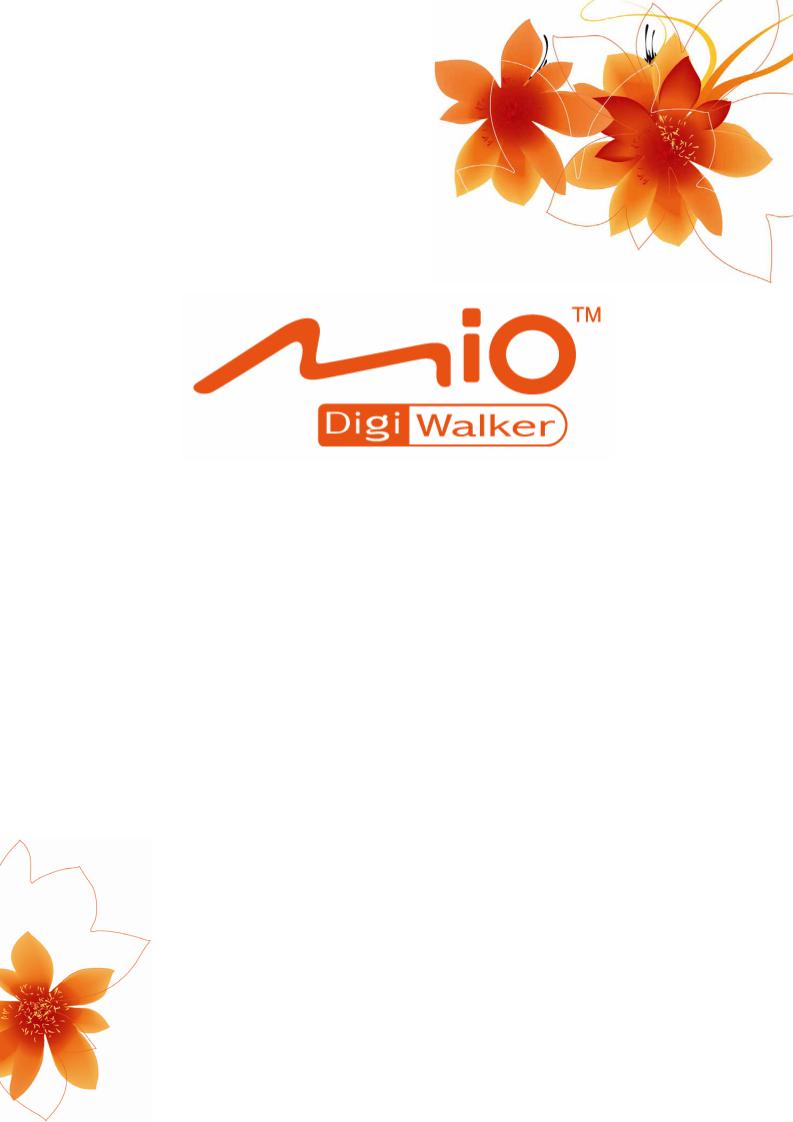
User Manual
MioMap™ v3.2
Navigation software for Mio DigiWalker P350/P550
US English
August, 2006 (v1.00)
Copyright note
The product and the information contained herein may be changed at any time without prior notification.
This manual nor any parts thereof may not be reproduced or transmitted in any form either electronically or mechanically, including photocopying and recording, without the express written consent of Mio Technology Limited.
©2006 Mio Technology Limited
©2006 Nav N Go Kft.
Whereis® map data is © 2006 Telstra Corporation Limited and its licensors
Data Source |
© 2006 Tele Atlas N.V. |
Austria: |
© BEV, GZ 1368/2003 |
Denmark: |
© DAV |
France: |
© IGN France |
Great Britain: |
Ordnance Survey data with permission of Her Majesty’s |
|
Stationery Office © Crown Copyright |
Italy: |
© Geonext/DeAgostini |
Northern Ireland: |
© Ordnance Survey of Northern Ireland |
Norway: |
© Norwegian Mapping Authority, Public Roads Administration / |
|
Mapsolutions |
Switzerland: |
© Swisstopo |
The Netherlands: |
Topografische ondergrond |
|
Copyright © dienst voor het kadaster en de openbare registers, |
|
Apeldorn |
All rights reserved. |
|
2
Thank you for choosing MioMap as your door-to-door in-car navigator. Read the
Quick Start Guide first and start using MioMap right away. This document is the detailed description of the software. Although MioMap can easily be discovered by experience, it is still recommended that you read through this manual to clearly understand the exact function of each button and icon.
3
Table of Contents
1 Warnings and safety information......................................................................... |
8 |
||||
2 |
General information............................................................................................. |
9 |
|||
3 |
Operating MioMap (Controls)............................................................................ |
10 |
|||
|
3.1.1 |
Power on/off........................................................................................ |
10 |
||
|
3.1.2 |
Tilt up and down ................................................................................. |
10 |
||
|
3.1.3 |
Zoom in and out.................................................................................. |
10 |
||
|
3.1.4 |
Rotate left and right ............................................................................ |
11 |
||
|
3.1.5 |
Voice instruction announcement......................................................... |
11 |
||
|
3.1.6 |
The Route Information screen ............................................................ |
11 |
||
|
3.2 Screen buttons and controls ...................................................................... |
12 |
|||
|
3.2.1 |
Direct selectors ................................................................................... |
12 |
||
|
3.2.2 |
List selectors....................................................................................... |
12 |
||
|
3.2.3 |
Sliders................................................................................................. |
12 |
||
|
3.2.4 |
Switches ............................................................................................. |
13 |
||
|
3.2.5 |
Switches in the Quick menu................................................................ |
13 |
||
|
3.2.6 |
Virtual keyboards ................................................................................ |
13 |
||
|
|
3.2.6.1 |
QWERTY-type keyboards ............................................................... |
14 |
|
|
|
3.2.6.2 |
The numeric keyboard..................................................................... |
14 |
|
4 Discovering the program through the screens .................................................. |
15 |
||||
|
4.1 |
The map..................................................................................................... |
15 |
||
|
4.1.1 |
2D and 3D map views......................................................................... |
15 |
||
|
4.1.2 |
Zoom levels ........................................................................................ |
16 |
||
|
4.1.3 |
Daylight and night color schemes ....................................................... |
16 |
||
|
4.1.4 |
Streets and roads ............................................................................... |
18 |
||
|
4.1.5 |
Other objects ...................................................................................... |
18 |
||
|
4.1.6 |
Speed cameras................................................................................... |
19 |
||
|
4.1.7 |
Contacts.............................................................................................. |
19 |
||
|
4.1.8 |
Elements of the Active Route.............................................................. |
19 |
||
|
|
4.1.8.1 The start point, via points and the destination ................................. |
19 |
||
|
|
4.1.8.2 |
Animated turn guidance .................................................................. |
20 |
|
|
|
4.1.8.3 |
The route line .................................................................................. |
20 |
|
|
|
4.1.8.4 Roads in the route excluded by your preferences ........................... |
20 |
||
|
4.2 |
Screens with map ...................................................................................... |
21 |
||
|
4.2.1 |
Turn preview (No. 1) ........................................................................... |
23 |
||
|
4.2.2 |
Zoom in and out (No. 2 & 3)................................................................ |
23 |
||
|
4.2.3 |
Tilt up and down (No. 4 & 5) ............................................................... |
24 |
||
|
4.2.4 |
Lock to GPS position and heading (No. 6).......................................... |
24 |
||
|
4.2.5 |
Cursor (No. 7) ..................................................................................... |
25 |
||
|
4.2.6 |
Map scale (No. 8) ............................................................................... |
25 |
||
|
4.2.7 |
Menu (No. 9)....................................................................................... |
25 |
||
4
4.2.8 |
Map orientation and Overview (No. 10) .............................................. |
26 |
||
4.2.9 |
GPS position quality (No. 11).............................................................. |
26 |
||
4.2.10 |
Battery status (No. 12)........................................................................ |
27 |
||
4.2.11 |
Sound muting (No. 13)........................................................................ |
27 |
||
4.2.12 |
Track Log recording/playback indicator (No. 14) ................................ |
28 |
||
4.2.13 |
Cursor menu (No. 15) ......................................................................... |
28 |
||
4.2.14 |
Current street (No. 16)........................................................................ |
30 |
||
4.2.15 |
Travel and Route data (No. 17) .......................................................... |
31 |
||
4.2.16 |
Distance to next turn (No. 18) ............................................................. |
31 |
||
4.2.17 |
Next street / Next settlement (No. 19)................................................. |
31 |
||
4.2.18 |
Approaching next turn (No. 20)........................................................... |
32 |
||
4.2.19 |
Current speed limit (No. 21)................................................................ |
32 |
||
4.3 |
GPS Data screen ....................................................................................... |
32 |
||
4.3.1 |
GPS data displayed ............................................................................ |
33 |
||
4.3.2 |
GPS connection indicator ................................................................... |
33 |
||
4.3.3 |
GPS data quality indicator .................................................................. |
33 |
||
4.3.4 |
Time synchronization.......................................................................... |
34 |
||
4.3.5 |
GPS configuration (Detect and Config.).............................................. |
34 |
||
4.4 |
Route Information screen........................................................................... |
34 |
||
4.4.1 |
Route data displayed (for destination and via points) ......................... |
35 |
||
|
4.4.1.1 |
Route line ........................................................................................ |
35 |
|
|
4.4.1.2 |
Distance Left ................................................................................... |
36 |
|
|
4.4.1.3 |
Method ............................................................................................ |
36 |
|
|
4.4.1.4 |
Time Left ......................................................................................... |
36 |
|
|
4.4.1.5 |
Estimated Arrival ............................................................................. |
36 |
|
|
4.4.1.6 Destination / Via point ..................................................................... |
36 |
||
4.4.2 |
Warning icons ..................................................................................... |
37 |
||
4.4.3 |
Fit to screen ........................................................................................ |
38 |
||
4.4.4 |
Parameters ......................................................................................... |
38 |
||
4.5 |
Menu |
.......................................................................................................... |
38 |
|
4.5.1 |
Find tab............................................................................................... |
38 |
||
4.5.2 |
Quick .............................................................................................tab |
38 |
||
|
4.5.2.1 .........................................................................Zoom & Tilt (switch) |
39 |
||
|
4.5.2.2 .....................................................Daylight & Night Modes (switch) |
39 |
||
|
4.5.2.3 ......................................................Manage POI (Points of Interest) |
40 |
||
|
4.5.2.4 .............................................................. |
Popup Information (switch) |
43 |
|
|
4.5.2.5 ......................................................................... |
Manage Track Logs |
44 |
|
4.5.3 |
Route ............................................................................................tab |
46 |
||
|
4.5.3.1 ..................................................................................... |
Recalculate |
46 |
|
|
4.5.3.2 .............................................................................................. |
Delete |
48 |
|
|
4.5.3.3 ........................................................................................... |
Itinerary |
48 |
|
|
4.5.3.4 ........................................................................................... |
Fly Over |
49 |
|
|
4.5.3.5 .................................................................................................. |
Edit |
50 |
|
|
4.5.3.6 .................................................................................................. |
Info |
51 |
|
4.5.4 |
Main .........................................................................................button |
51 |
||
4.6 |
Speed ..........................................................................................cameras |
51 |
||
4.6.1 |
Camera .....................................................................................types |
52 |
||
|
4.6.1.1 ................................................................................. |
Fixed cameras |
52 |
|
|
4.6.1.2 ............................................................................... |
Mobile cameras |
52 |
|
|
4.6.1.3 .............................................................................. |
Built - in cameras |
52 |
|
5
|
|
4.6.1.4 |
Section control cameras.................................................................. |
53 |
|
|
4.6.2 |
Controlled traffic direction ................................................................... |
53 |
||
|
4.6.3 |
Speed limit checked............................................................................ |
54 |
||
|
4.6.4 |
Add a new camera or edit an existing one.......................................... |
54 |
||
|
4.6.5 |
Change the settings of the camera warning........................................ |
54 |
||
|
4.7 TMC (Traffic Message Channel) ................................................................ |
54 |
|||
|
4.7.1 |
List of TMC messages ........................................................................ |
55 |
||
|
4.7.2 |
TMC control center ............................................................................. |
55 |
||
|
|
4.7.2.1 Selected FM radio station................................................................ |
56 |
||
|
|
4.7.2.2 |
Exclude selected station.................................................................. |
56 |
|
|
|
4.7.2.3 |
Show excluded stations................................................................... |
56 |
|
|
|
4.7.2.4 Sorts events by distance / type ....................................................... |
56 |
||
|
|
4.7.2.5 |
Use traffic information ..................................................................... |
57 |
|
|
|
4.7.2.6 Recalculate to avoid traffic .............................................................. |
57 |
||
5 |
Find ................................................................................................................... |
|
|
58 |
|
|
5.1 Main menu Find buttons (Address, Favorites, POI, History) ...................... |
58 |
|||
|
5.2 Selection by tapping the map..................................................................... |
58 |
|||
|
5.3 Using the Find menu.................................................................................. |
59 |
|||
|
5.3.1 |
Find an Address, Street, Intersection or City ...................................... |
59 |
||
|
|
5.3.1.1 Selecting the city, state and country to search in ............................ |
60 |
||
|
|
5.3.1.2 Selecting a house number or the midpoint of the street .................. |
63 |
||
|
|
5.3.1.3 How to select an intersection instead of a house number ............... |
64 |
||
|
|
5.3.1.4 An example for a full address search .............................................. |
64 |
||
|
5.3.2 |
Find in History..................................................................................... |
65 |
||
|
5.3.3 |
Find Coordinates ................................................................................ |
65 |
||
|
5.3.4 |
Find a POI........................................................................................... |
66 |
||
|
5.3.5 |
Find one of the Favorites (Home/Work).............................................. |
68 |
||
6 |
Settings ............................................................................................................. |
|
|
69 |
|
|
6.1 |
General settings......................................................................................... |
69 |
||
|
6.1.1 |
Safety Mode........................................................................................ |
69 |
||
|
6.1.2 |
Automatic Night Colors ....................................................................... |
70 |
||
|
6.1.3 |
Speed Warning Options...................................................................... |
70 |
||
|
|
6.1.3.1 |
Speeding tolerance ......................................................................... |
70 |
|
|
|
6.1.3.2 |
Alternative speed limit ..................................................................... |
70 |
|
|
|
6.1.3.3 |
Alternative speeding tolerance ........................................................ |
70 |
|
|
6.1.4 |
Enable Speed Camera Warning ......................................................... |
71 |
||
|
6.1.5 |
Speed Camera Options ...................................................................... |
71 |
||
|
|
6.1.5.1 |
Audible Warning.............................................................................. |
71 |
|
|
|
6.1.5.2 |
Visible Warning ............................................................................... |
72 |
|
|
6.1.6 |
Set Favorite Destinations.................................................................... |
73 |
||
|
6.1.7 |
Route Recalculation............................................................................ |
73 |
||
|
|
6.1.7.1 |
Automatic ........................................................................................ |
74 |
|
|
|
6.1.7.2 |
Disabled .......................................................................................... |
74 |
|
|
6.1.8 |
Display Orientation ............................................................................. |
74 |
||
|
6.2 |
Sound settings ........................................................................................... |
74 |
||
|
6.2.1 |
Master sound volume/switch............................................................... |
74 |
||
|
6.2.2 |
Voice guidance volume/switch............................................................ |
75 |
||
|
6.2.3 |
Key sound volume/switch ................................................................... |
75 |
||
|
6.2.4 |
Dynamic Volume................................................................................. |
75 |
||
|
6.2.5 |
Attention Tone .................................................................................... |
75 |
||
6
|
6.3 |
Route parameter settings........................................................................... |
76 |
||
|
6.3.1 |
Route .................................................................................................. |
76 |
||
|
|
6.3.1.1 |
Shortest........................................................................................... |
76 |
|
|
|
6.3.1.2 |
Fastest ............................................................................................ |
76 |
|
|
|
6.3.1.3 |
Economical...................................................................................... |
76 |
|
|
6.3.2 |
Vehicle ................................................................................................ |
76 |
||
|
6.3.3 |
Road types to include/exclude ............................................................ |
77 |
||
|
|
6.3.3.1 |
Unpaved Roads .............................................................................. |
77 |
|
|
|
6.3.3.2 |
Motorways....................................................................................... |
77 |
|
|
|
6.3.3.3 |
Ferries ............................................................................................. |
77 |
|
|
|
6.3.3.4 |
U-turns ............................................................................................ |
77 |
|
|
|
6.3.3.5 |
Permit needed................................................................................. |
78 |
|
|
|
6.3.3.6 |
Toll Roads ....................................................................................... |
78 |
|
|
|
6.3.3.7 |
Cross-border Planning .................................................................... |
78 |
|
|
6.4 |
Language & Units ...................................................................................... |
78 |
||
|
6.4.1 |
Program language .............................................................................. |
78 |
||
|
6.4.2 |
Voice language ................................................................................... |
79 |
||
|
6.4.3 |
Units.................................................................................................... |
79 |
||
|
6.4.4 |
Set Date & Time Format ..................................................................... |
79 |
||
|
6.5 |
Advanced settings...................................................................................... |
79 |
||
|
6.5.1 |
Cockpit settings .................................................................................. |
80 |
||
|
|
6.5.1.1 3D in Cockpit mode (and track-up orientation) ................................ |
80 |
||
|
|
6.5.1.2 |
Cockpit screen layout ...................................................................... |
80 |
|
|
6.5.2 |
Backlight settings................................................................................ |
80 |
||
|
|
6.5.2.1 |
Power management ........................................................................ |
81 |
|
|
|
6.5.2.2 |
Brightness ....................................................................................... |
81 |
|
|
6.5.3 |
User data management ...................................................................... |
81 |
||
|
|
6.5.3.1 |
Backup Data.................................................................................... |
82 |
|
|
|
6.5.3.2 |
Restore Data ................................................................................... |
82 |
|
|
|
6.5.3.3 |
Clear Data ....................................................................................... |
82 |
|
|
|
6.5.3.4 |
Reset Advanced Settings ................................................................ |
82 |
|
|
6.5.4 |
Map options ........................................................................................ |
83 |
||
|
|
6.5.4.1 Daylight / Night color profile ............................................................ |
83 |
||
|
|
6.5.4.2 |
Show Street Labels ......................................................................... |
83 |
|
|
|
6.5.4.3 |
Textured Polygons .......................................................................... |
83 |
|
|
6.5.5 |
Smart Zoom ........................................................................................ |
83 |
||
|
|
6.5.5.1 |
Enable Smart Zoom ........................................................................ |
84 |
|
|
|
6.5.5.2 |
Enable Overview mode ................................................................... |
84 |
|
|
|
6.5.5.3 Keep position on road (Lock-on-Road)............................................ |
85 |
||
|
6.6 |
About screen.............................................................................................. |
85 |
||
|
6.7 |
Manual GPS configuration ......................................................................... |
85 |
||
|
6.7.1 |
Protocol............................................................................................... |
86 |
||
|
6.7.2 |
Port ..................................................................................................... |
86 |
||
|
6.7.3 |
Baud rate ............................................................................................ |
86 |
||
7 |
Troubleshooting guide....................................................................................... |
87 |
|||
8 |
Glossary |
............................................................................................................ |
|
89 |
|
7
1 Warnings and safety information
MioMap is a navigation system that helps you find your way to your selected destination. It will determine your exact location with the help of an attached GPS device. The position information obtained from the GPS receiver will not be transmitted anywhere, so others will not be able to track you by the help of this program.
If you are the driver of the vehicle, we recommend that you operate MioMap before beginning your journey. The driver’s attention should be on the road. Plan your route before departure and pull over if you need to change route parameters. MioMap has a built-in (optional) Safety Mode that will prevent you from using the screen functions if your car is in motion. Unless a passenger will be the only one to operate MioMap, we strongly encourage you to turn on the Safety Mode.
It is also important that you look at the display only if it is absolutely safe to do so.
You should always observe traffic signs and road geometry before you obey any instruction from MioMap. If you need to deviate from the recommended direction, MioMap will suggest a modified route according to the new situation.
Never place the PDA where it can obstruct the view of the driver, is within the deployment zone of airbags, or where it can cause injuries in case of an accident.
8
2 General information
MioMap is a navigation system optimized for in-car use. It provides door-to-door navigation for both single and multi-point routes using adaptable route parameters. MioMap is capable of planning routes throughout the whole map region installed on the memory card. Unlike some other products, MioMap does not require that you change maps or switch to a poorly detailed general map to navigate between map segments or countries. You always have complete freedom to go wherever you wish.
Just select your destination and go.
You do not need a stylus to use MioMap. All screen buttons and controls are designed so that you can operate them with your fingertips.
You can access all functions of the program by using hardware and screen buttons.
With the help of these buttons you can travel through all the screens of the program.
Most of the screens (especially menu functions and settings) can be accessed from several other screens, minimizing the number of actions needed to reach the desired function.
When using MioMap, you do not need to ‘double tap’ or ‘tap & hold’ the touch screen as these functions cannot be used reliably in a moving vehicle. A single tap triggers most of the screen controls. The only exceptions are ‘drag & drop’ for moving the map, or scaling it in Map mode (Page 25).
Most of the screens have a Return button  in the top left corner. This arrow returns to the previous screen or directly to one of the map screens.
in the top left corner. This arrow returns to the previous screen or directly to one of the map screens.
Settings screens also have a Help button  in the top right corner. This will show a detailed description of the current settings screen.
in the top right corner. This will show a detailed description of the current settings screen.
9

3 Operating MioMap (Controls)
MioMap is designed for easy operation. All controls are operable by fingertips.
Wherever possible, pushbuttons and lists are provided to make accessing functions or changing settings as easy as possible.
3.1.1 Power on/off
Use this button to turn the power of the Mio DigiWalker P350/P550 on or off any time.
If the device power is turned off while MioMap is running, when you turn the device back on, MioMap will continue the navigation as soon as the built-in GPS determines the location again.
While the device is switched off, the GPS will not work, no position will be calculated, track log will not be saved, and navigation will stop.
3.1.2 Tilt up and down
Map tilting modifies the vertical view angle of the map in 3D mode. This function is explained in detail here: Page 24.
Note: The Tilt down button has a special function when starting Fly Over (Page 49), the route simulation. If started while keeping this button depressed, the simulation will be fast to give you a rough overview of the route events.
3.1.3 Zoom in and out
Tilt the joystick up to zoom in, or tilt it down to zoom out.
Zoom will change the scale of the map in both 2D and 3D map modes. This function is explained in detail here: Page 23.
Note: When applied on list and menu screens, this action will move the highlight up and down.
10
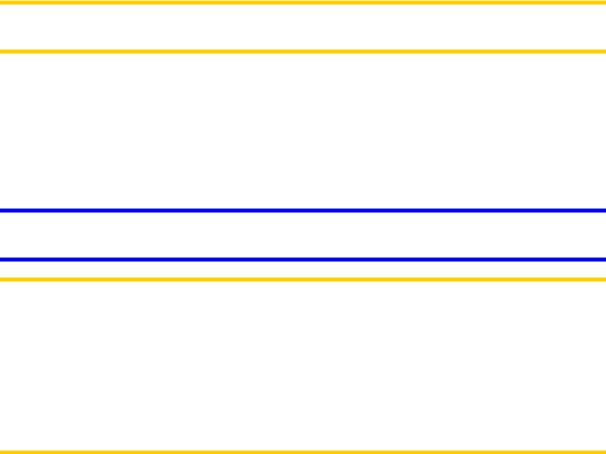
3.1.4 Rotate left and right
Tilt the joystick left or right to rotate the map.
Track-up map orientation (Page 26) will always rotate the map so its top faces your direction of travel when your GPS position is available. Use this function if you need to check something on your left or right.
If you rotate the map during navigation, Smart Zoom will still zoom and tilt the map but the automatic rotation (Track-up) will be deactivated, so the map orientation will remain as you set it. You need to press Enter, or tap the Lock button (Page 24) to reactivate the automatic map rotation.
Note: When applied on list and menu screens, this action will move the highlight left and right.
3.1.5 Voice instruction announcement
Press the joystick for this function.
When using either the Map or the Cockpit screen, you can repeat the latest voice instruction by pushing this button.
Tip: Use this button any time during your journey if you need the distance and type of the next route event.
Note: In order to receive voice instructions, sound should not be muted (Page 74), voice guidance must be enabled (Page 75), and a route must be active.
Note: If you have disabled Smart Zoom by tilting, rotating or moving the map during navigation (i.e. the Lock button appears on the screen), this button will first re-enable normal navigation, and will say the instruction only after being pushed again.
Note: When applied on list and menu screens, this button will select the highlighted item.
3.1.6 The Route Information screen
To give easy access to the most important data screen during navigation, a hardware button is reserved for opening the Route Information screen. Alternatively, tap the travel data fields of the Cockpit screen (Page 21) or the Info button (Page 51) in the Route menu to display this screen.
11
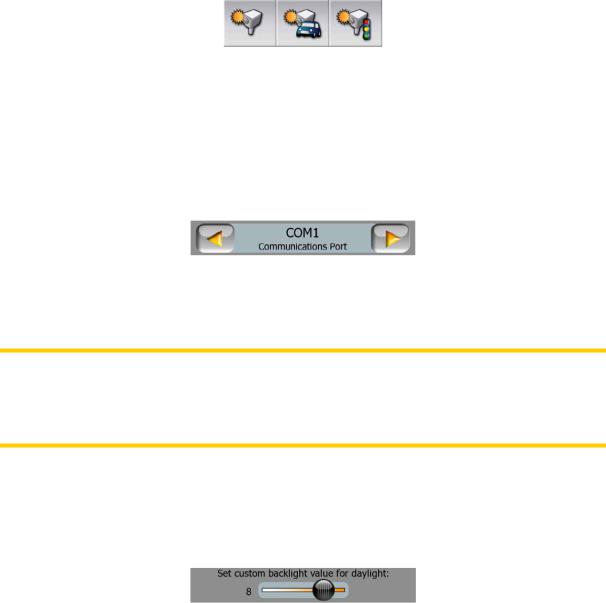
3.2 Screen buttons and controls
The primary input channel of MioMap is the touch screen. If you read on, you will realize that most parts of the screen are not only used to display information but also to initiate functions by tapping. Below you will find a list of the most frequently used controls in the program.
3.2.1 Direct selectors
Some of the settings can be chosen from a short list of possible values. If the values can be described graphically, all values are available on the screen.
Tap one of the icons to set/change the value.
3.2.2 List selectors
When the values in the list need to be named, only the current value is shown
(sometimes together with a short description) in a horizontal stripe with arrows at both ends.
The arrows are buttons. Tap  to move left in the list or tap
to move left in the list or tap  to move right. You need not confirm your selection. As soon as you leave the screen, the selected value becomes effective.
to move right. You need not confirm your selection. As soon as you leave the screen, the selected value becomes effective.
Note: The only exception for this is the Manual GPS Configuration screen (Page 85) where you can confirm your new set of selections by tapping the  button, or
button, or
leave the previous settings untouched by exiting with the  button in the top left corner.
button in the top left corner.
3.2.3 Sliders
When a feature has several different unnamed (numeric) values, MioMap will show sliders that look like analogue potentiometers to set the desired value.
If the value limits are not displayed at the ends of the slider, the leftmost position means the minimum value, while the rightmost position represents the maximum value.
12
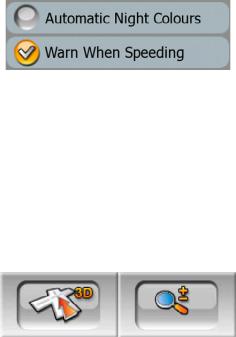
With most sliders you can check the current value on the left.
This control can be operated in two ways. Either drag the handle to move the slider to its new position, or tap the slider where you want the handle to appear (the thumb jumps there immediately). As with the list selectors, there is no need to confirm your selection. As soon as you leave the screen, the selected value becomes effective.
3.2.4 Switches
When a function can only have two values (mainly Enabled and Disabled), a switch is used. Unlike with list selectors, the horizontal line contains the name of the function and not the actual status. There is a lamp on the left to show whether the function is active or not.
When the tick mark is missing  , the function is not selected. When it is displayed
, the function is not selected. When it is displayed
 , the function is enabled. The whole strip works as a button. Tap anywhere to toggle between the enabled and disabled status.
, the function is enabled. The whole strip works as a button. Tap anywhere to toggle between the enabled and disabled status.
3.2.5 Switches in the Quick menu
The switches of the Quick menu (Page 38) behave as normal switches but they look different in order to fit in with the other menu buttons.
Tap the button to toggle between the two states. Remember that the sign on the button will not indicate the current state but the state you can switch it to.
3.2.6 Virtual keyboards
MioMap is designed in a way that you only need to enter letters or numbers when it is inevitable. In these cases a full screen keyboard pops up that can easily be operated with your fingertips. You can choose between a separate ABC and numeric keypad, or a set of QWERTY-type keyboards that contain both letters and numbers.
MioMap will remember your last choice and offer it the next time you need to enter data.
The alphabetic keyboards in MioMap do not contain special characters, because you do not need to enter accents when searching for a destination. Type only the base letters (the letter most similar to the accented one) and MioMap will search for all
13
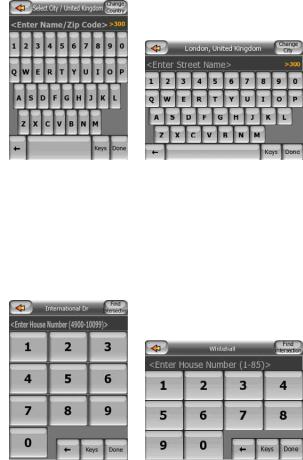
their combinations in the database (e.g. for the French street ‘Cité Bergère ’ you only need to type ‘Cite Bergere’, and the rest is done by the program).
When you type in POI or track log names, MioMap will automatically turn all initials into capitals to create names that look pleasant.
3.2.6.1 QWERTY-type keyboards
QWERTY-type keyboards have both letters and numbers on them. Their layout is the same as of the standard QWERTY and AZERTY (French) keyboards. To switch to your desired QWERTY-type keyboard, press the Keys button.
The special keys described in the previous section are also available here.
3.2.6.2 The numeric keyboard
The numeric keyboard only contains numbers, on huge buttons. The special keys you find on the other keyboards (except Space) are available here as well.
Although QWERTY-type keyboards also contain number keys, when entering a house number, the program offers the more convenient numeric keypad.
14
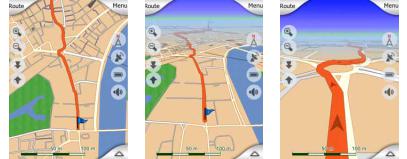
4 Discovering the program through the screens
The best way to discover MioMap is to explore each screen in detail, and to find out how to move from one to another. Read this chapter for a guided tour.
4.1 The map
The most important and most frequently used screens of MioMap are the two screens with the map (Map screen and Cockpit screen). They are similar in look and in possible controls but are optimized for different uses. The map they display is common. The elements of the map are described here. For the controls and special functions of the two map screens see Page 21.
The current version of MioMap is primarily intended for land navigation. That is why maps in MioMap look similar to paper roadmaps (when using daytime colors and 2D map mode). However, MioMap provides much more than regular paper maps can. The look and the contents can be changed.
4.1.1 2D and 3D map views
Besides the classical top down view of the map (called 2D mode), you have the possibility to tilt the map to have a perspective view (3D mode) that gives a view similar to that seen through the windscreen with the possibility to see far ahead.
It is easy to change between 2D and 3D modes. You have two options. You can use the Tilt up and down buttons (Page 24) to tilt the map seamlessly between 2D and all
3D angles, or you can use the switch in the Quick menu (3D Map) to quickly switch between the two modes.
15
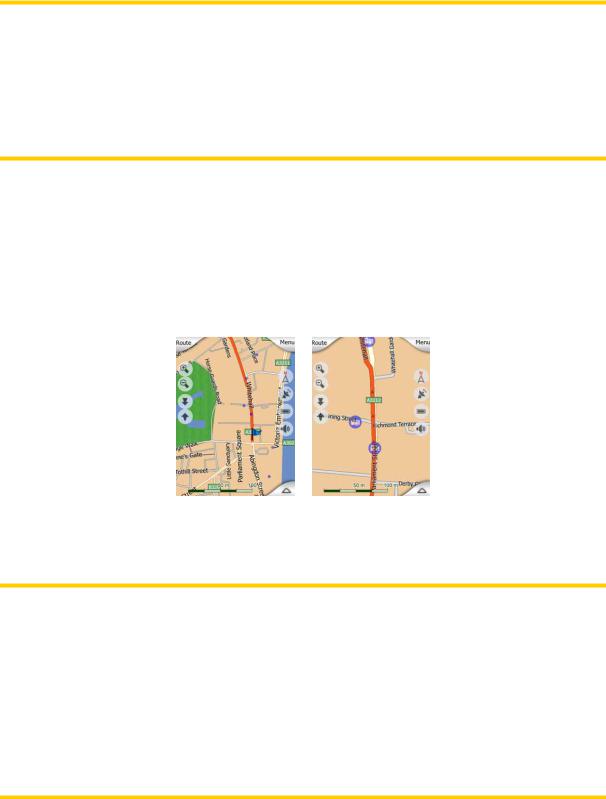
Note: You may find that 2D mode is more useful in North-up Map mode when looking for a certain part of the map or an object to select as destination. On the other hand, 3D mode in Track-up Cockpit mode with Smart Zoom makes navigation very comfortable. The description of these modes will come later in this manual.
Note: Using the Advanced settings, you can force Cockpit mode to always start in 3D
Track-up view (Page 80). You can still rotate and tilt the maps in either mode, but the next time you enter this screen, the preset look will reappear.
4.1.2 Zoom levels
MioMap uses high quality vector maps that let you see the map at various zoom levels, always with optimized content. Street names and other text objects are always displayed with the same font size, never upside down, and you only see as many streets and objects as needed to find your way around the map. Zoom in and out to see how the map changes in either the 2D or 3D view.
Changing the scale of the map is very easy. You can drag and stretch the scale (Page 25) at the bottom of the Map screen, or use the zoom icons (Page 23) on both Map and Cockpit screens.
Note: If you need to zoom out briefly to locate your position on the map, use the
Overview mode instead of zooming out and back in. The Overview mode is a 2D North-up view that can be started by tapping the compass button on the right (Page 26).
Note: MioMap has a special Smart Zoom function for navigation that automatically rotates, scales and tilts the map in 3D map mode to always give you the optimal view in your current situation. When approaching a turn, it will zoom in and raise the view angle to let you easily recognize your maneuver at the next junction. If the next turn is at a distance, it will zoom out and lower the view angle to flat in order to let you see the road in front of you.
4.1.3 Daylight and night color schemes
The different color schemes let you adjust MioMap to the brightness of the environment. Use the daylight and night color schemes accordingly. Daylight colors are similar to paper roadmaps, while the night color schemes use dark tints for large
16
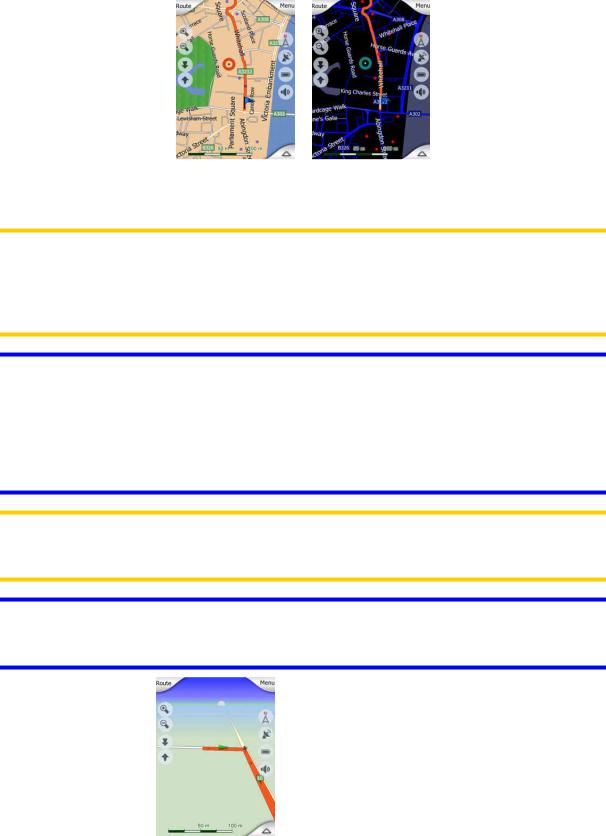
objects to keep the average brightness of the screen low, with carefully selected colors to still keep you informed about all the necessary information on the screen.
You can change between day and night views manually in the Quick Menu (Page 39) or let MioMap do it automatically (Page 70) for you.
Note: The automatic day/night mode is based upon the current date and GPS position by which MioMap calculates the exact sunrise and sunset times on the particular day at the particular location. Using that information MioMap can automatically switch between the color schemes a few minutes before sunrise, when the sky has already turned bright, and a few minutes after sunset before it gets dark.
Tip: There are several daytime and night color schemes included with MioMap. To select the one that suits your needs the best, make your selection in Settings (Page
83).
Tip: To further enhance the effect of the night color scheme, you can instruct MioMap to decrease the display backlight when the night colors are used. Set the desired backlight levels for both daylight and night modes. Page 80.
Note: The colors mentioned and screenshots included in this manual refer to the default daytime and night color schemes. They may not look the same in the schemes you have chosen.
Tip: If you use MioMap after sunrise or before sunset, look for the sun in the sky in the map background using a flat 3D view. It is displayed at its actual position to give you another way to orientate, and also to provide some eye candy.
17
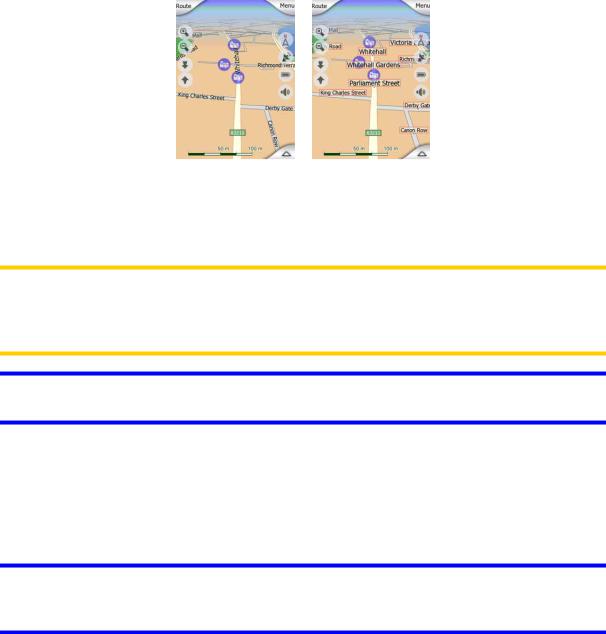
4.1.4 Streets and roads
The similarity of MioMap to paper roadmaps is also convenient when it comes to streets, the most important elements of the map concerning navigation. MioMap uses similar color codes to those you are accustomed to, and the width of the streets also refers to their importance, so it will not be difficult to tell a highway from a small street.
Streets and roads have names or numbers for identification. Of course, this information can be displayed on the map. MioMap uses two different ways to show street labels. The conventional way is the same as a roadmap – it displays the name of the street aligned with the street. The alternative is a kind of virtual signpost stuck into the street itself.
You need not choose between the two modes. MioMap will use the one best for the current tilt and zoom level. Zoom in to have only a few streets on the map, and start tilting up and down to see how MioMap switches between the two modes in an instant.
Note: The automatic switching is on even when using Smart Zoom. At first you may find it odd, but later you will discover how it adjusts the displayed information to the current view of the map. It is important, as the driver must be able to read the map at a glance.
Tip: If you do not want to be bothered by street names during navigation, turn them off in Map Options (Page 83).
4.1.5 Other objects
To help orientate you, the map also contains objects that have no other navigating function than to help you recognize your location on the map. These are surfacewaters, large buildings, forests, etc.
Tip: These objects are normally displayed using textured polygons that look natural to the eye. You may wish to switch the textured display off (Page 83) to free some of the resources of your PDA by replacing textures with plain colored surfaces.
18

4.1.6 Speed cameras
There are special POI types in MioMap. There is a built-in database of fixed and mobile speed cameras. It is also possible to add new cameras to enhance this database. They are not shown in POI lists, but they are shown on the map with special icons. Speed cameras are described in detail here: Page 51
4.1.7 Contacts
A different type of special POIs are Contacts. When MioMap is started, it will attempt to recognize the addresses in your Mio DigiWalker P350/P550’s Contact database.
All contacts with the address recognized will be shown as My POIs in a group named Contacts.
If they exist, both the home and work addresses of a contact will be imported. For example if you have the home and office addresses of John Smith, you will have two POIs, one called ‘John Smith (Home)’, and another one as ‘John Smith (Work)’.
4.1.8 Elements of the Active Route
MioMap uses a multi-destination routing system in which you have a start point (your current location if GPS position is available), a destination, the line of the active leg of the route, and optionally via points and inactive legs. They are all shown on the map.
4.1.8.1 The start point, via points and the destination
These points are represented by flags.
19
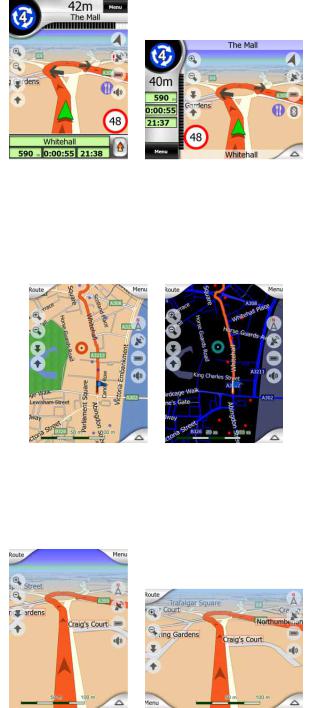
4.1.8.2 Animated turn guidance
Animated arrows represent all route events other than the above-mentioned special points. These arrows show the direction in which you need to continue your journey.
4.1.8.3 The route line
The line representing the planned route is displayed in orange with both daylight and night colors. In both cases it is the most conspicuous part of the map even when in the background of a 3D map view.
The line of the route is displayed on the driving side of the road for two-way and on the axis in case of one-way streets. When the map is zoomed in and the line is wide enough, small arrows show the direction of the route. This can be useful if you preview the route before starting the journey or when entering a complex junction.
4.1.8.4 Roads in the route excluded by your preferences
Although you can choose whether to include or avoid some road types in Route parameter settings (Page 77), sometimes they are impossible to avoid near the starting point, via points or the destination.
If so, MioMap will display those segments of the route with an alternate color.
20

4.2 Screens with map
Having explained the contents of the map, the description of the other parts of the map screens follows. There are two map screens: the Map screen and the Cockpit screen. The way they show the map is the same but their look and controls are optimized for different purposes.
The Map screen is to be used mainly without a GPS, to browse the map, create user POI items, or to plan your route based on map points. The Map screen is designed to give you the maximum map area. This screen is usually used in 2D North-up mode.
The Cockpit screen is for driving purposes. Besides showing the map, it contains some additional travel information if you are just cruising (speed, current street your are driving in, speed limit for the current street), and some more route data if you are navigating (e.g. next street in your route, distance to travel, type of the next route event). This screen is typically used in 3D Track-up mode (you can make MioMap always open the Cockpit screen like that.
There are several controls that function in a similar fashion on the two screens. They are described on the following pages.
Map screen contents:
Cockpit screen contents:
21
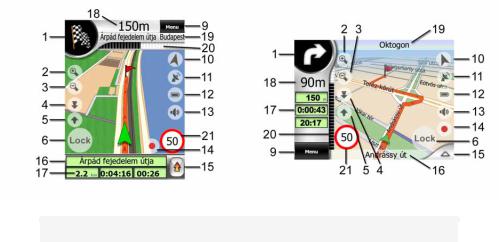
No. Display
1(Cockpit only) Turn preview*
2n/a
3n/a
4n/a
5n/a
6Indicates that Lock to GPS position and heading is inactive
7Selected map point (Cursor)
8(Map only) Map scale
9n/a
10Map orientation and Overview
11GPS position quality
12Battery status
13Sound on or muted
14Track Log recording or playback
15n/a
16(Cockpit only) Current street
17(Cockpit only) Travel and Route data**
18(Cockpit only) Distance to next turn***
19(Cockpit only) Next street***
20(Cockpit only) Approaching next
22
Control
Opens Route menu*
Zooms in (optional)
Zooms out (optional)
Tilts down (optional)
Tilts up (optional)
Re-enables Lock-to-
Position / Smart Zoom
Opens Popup Info and Cursor menu
Zooms in/out by dragging
Menu (Find, Quick,
Route, Main)
Switches North-up,
Track-up and Overview
Opens GPS Data screen
Opens settings
Enables/disables muting
Opens Track Logs screen
Opens Cursor menu
Opens Route Information screen
Opens Route Information screen
n/a
n/a
n/a
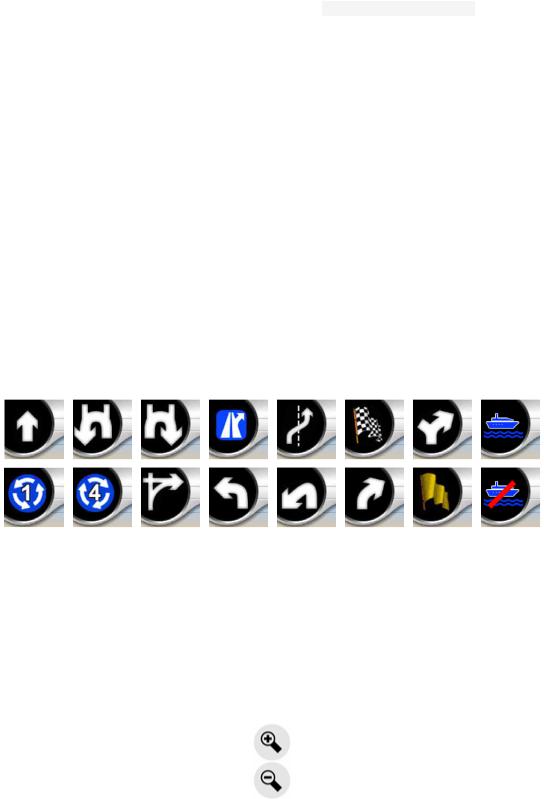
No. |
Display |
Control |
|
|
|
|
turn**** |
|
21 |
Current speed limit***** |
n/a |
*On Map screen only when a route is active
**Contents differ when a route is active
***Appears only when a route is active
****Appears only when a route is active and the next turn is near
*****Appears only if speed limit is known for the current road
4.2.1 Turn preview (No. 1)
On the Cockpit screen this field shows a graphic illustration of the next maneuver.
For example when you approach a turn, an arrow will show whether it is a slight, normal or sharp turn. When showing a roundabout, the number of the exit is also given in the picture.
This field also serves as a button. Tap it to get to the Route menu (Page 46). The
Map screen will show a button called Route here if there is an active route. This also leads to the Route menu.
4.2.2 Zoom in and out (No. 2 & 3)
These semi-transparent buttons are only displayed if "Zoom & Tilt" is enabled in the Quick menu (Page 39).
Zoom will change the scale of the map. Zoom out shows a larger part of the map, while Zoom in shows a smaller part of the map in more detail.
The automatic Smart Zoom function will do the necessary zooming for you when navigating (zooms out if the next turn is at a distance to let you see far ahead and zooms in when approaching a turn to give you a better view of the upcoming
23

maneuver). If you manually change the zoom level, Smart Zoom will no longer scale the map by itself (automatic tilting and rotating remains active).
You need to tap the Lock button (Page 24) to return the zoom control to Smart
Zoom. If you are on the Cockpit screen, MioMap will do this automatically if you leave the display untouched for 30 seconds.
4.2.3 Tilt up and down (No. 4 & 5)
These semi-transparent buttons are only displayed if "Zoom & Tilt" is enabled in the
Quick menu (Page 39).
This function modifies the vertical viewing angle of the map in 3D mode. You can change the angle in a wide range starting from a top down view (2D view is seamlessly integrated) all the way to a flat view that lets you see far ahead.
The automatic Smart Zoom function will do the necessary tilting for you when navigating (gives a flat view if the next turn is at a distance to let you see far ahead and raises the angle when approaching a turn to give you a better view of the upcoming maneuver). If you manually change the view angle, Smart Zoom will no longer tilt the map by itself (automatic zooming and rotating remains active).
You need to tap the Lock (Page 24) to return the tilt control to Smart Zoom. If you are on the Cockpit screen, MioMap will do this automatically if you leave the display untouched for 30 seconds.
4.2.4 Lock to GPS position and heading (No. 6)
This semi-transparent icon is displayed if GPS position is available, and the map has been moved or rotated. It also appears when you scale or tilt the map while Smart Zoom is enabled.
Normally MioMap positions the map to keep the GPS position visible somewhere on the map (when North-up orientation is selected), or always at the bottom center of the map (when Track-up orientation is selected).
If you manually move the map, it will freeze the map in the new position. To return to the GPS position, use this Lock button.
24
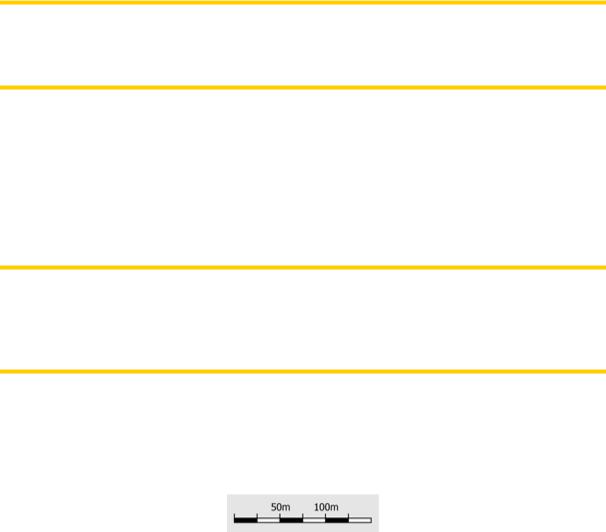
Rotating the map in any direction will only freeze the orientation of the map, but it keeps on moving to keep the GPS position visible. Use Lock to return to North-up or Track-up orientation (the one previously selected).
When Smart Zoom is enabled, scaling or tilting the map also stops the automatic zooming or automatic tilting respectively. To reactivate Smart Zoom, tap this button.
This button has a hardware button equivalent: Hardware buttons.
Note: When the Cockpit screen is open, you do not need to tap the Lock button. Just wait for 30 seconds without tapping the screen, and MioMap will automatically reenable Lock-to-Position and/or Smart Zoom. If you tap the screen during this period, the 30 seconds countdown will restart.
4.2.5 Cursor (No. 7)
As described earlier (Selected map point, also known as the Cursor), if you tap the map somewhere or select one specific item in Find, it will become the selected point on the map, marked with a small red dot and radiating red circles to make it conspicuous. You can use this point as starting point, via point or destination for your route, you can search for a POI near it, mark it with a pin, or save it as a POI.
Note: When GPS position is available, the Lock button will appear indicating that you have disabled Lock-to-Position. Tapping the Lock button will re-enable the position lock and move the cursor back to the current GPS position. The same happens when MioMap restores Lock-to-Position automatically on the Cockpit screen after 30 seconds of inactivity.
4.2.6 Map scale (No. 8)
The scale indicator is only available on the Map screen. In 2D map view it represents the scale of the map. In 3D view it is the scale of the nearest part of the map only.
You can use it in both 2D and 3D modes to scale the map. Drag and pull it right to zoom in, or left to zoom out.
4.2.7 Menu (No. 9)
This button opens the Menu with the Find engine, the Quick menu, the Route menu and the exit button that takes you to the Main menu screen. The Menu will be described in detail later: Page 38.
25

4.2.8 Map orientation and Overview (No. 10)
You can view the map screens in three different presentation modes. This switch will cycle through them in the following order.
The usual map orientation for navigation is Track-up. It means MioMap rotates the map during navigation to always face the direction of your travel. In this mode an arrow (compass) points towards North.
Tap this icon to switch to North-up mode. Now the map is fixed to keep facing North.
The icon changes to show the new rotation mode.
Tap the icon again to enter Overview mode. This mode looks similar to the North-up mode with one difference: the zoom level in this mode has a fixed default to give you a better look of where you are on the map. You can change the zoom level at any time, this will not cause the Lock button to appear, but when entering Overview mode later, the default zoom level will be restored.
The arrow representing your position will be fixed in the middle of the screen. When you move the map in Overview mode, the Lock button will appear, and when pushed, it will move the map to have your current position in the middle of the map again.
You cannot rotate the map in Overview mode. This mode is strictly north-up.
You can set up MioMap so that it will switch to Overview mode during navigation when the next turn is far away. You can specify this distance and the fixed zoom level of Overview in Advanced settings (Page 84).
An airplane icon indicates Overview mode.
Tap the icon again to return to Track-up (automatic rotation) mode.
4.2.9 GPS position quality (No. 11)
Similarly to the icon found on the GPS Data screen (Page 33), the map screens also inform you about the GPS signal:
• The black satellite dish with the red exclamation mark shows there is no connection with the GPS receiver. GPS navigation is not possible. Devices with a
The black satellite dish with the red exclamation mark shows there is no connection with the GPS receiver. GPS navigation is not possible. Devices with a
26

built-in GPS receiver are permanently connected, so this icon may not appear under normal circumstances.
• Red shows there is a connection, but the signal is too weak to give a position. GPS navigation is not possible.
Red shows there is a connection, but the signal is too weak to give a position. GPS navigation is not possible.
• Black shows there is a GPS position, and navigation is possible. When only one arc is shown, the position is 2D (no altitude available), and position error may be significant, yet MioMap is ready to navigate.
Black shows there is a GPS position, and navigation is possible. When only one arc is shown, the position is 2D (no altitude available), and position error may be significant, yet MioMap is ready to navigate.
• A black dish and two arcs represent a 3D GPS position. MioMap is ready to navigate.
A black dish and two arcs represent a 3D GPS position. MioMap is ready to navigate.
• When small car symbols are displayed under the dish, TMC information is available.
When small car symbols are displayed under the dish, TMC information is available.
4.2.10Battery status (No. 12)
The status of the battery is also shown by MioMap. You can estimate the available power reserve from the length of the bar inside. Some examples:
• The thunderbolt in the battery shows the battery is being charged.
The thunderbolt in the battery shows the battery is being charged.
• Battery is not charging, but it is at full capacity.
Battery is not charging, but it is at full capacity.
• Battery in not full, but there is sufficient reserve capacity.
Battery in not full, but there is sufficient reserve capacity.
• When the inside of the battery turns red, the battery needs recharging.
When the inside of the battery turns red, the battery needs recharging.
4.2.11Sound muting (No. 13)
By tapping this button you can quickly mute all sounds of the PDA. This will not modify the volume level and the enabled or disabled status of the voice guidance or the key sounds (all to be set on the Sound Settings screen: Page 74), just mutes the sound output. When muting is enabled, the speaker icon is crossed out.
Tap again to re-enable sounds.
27
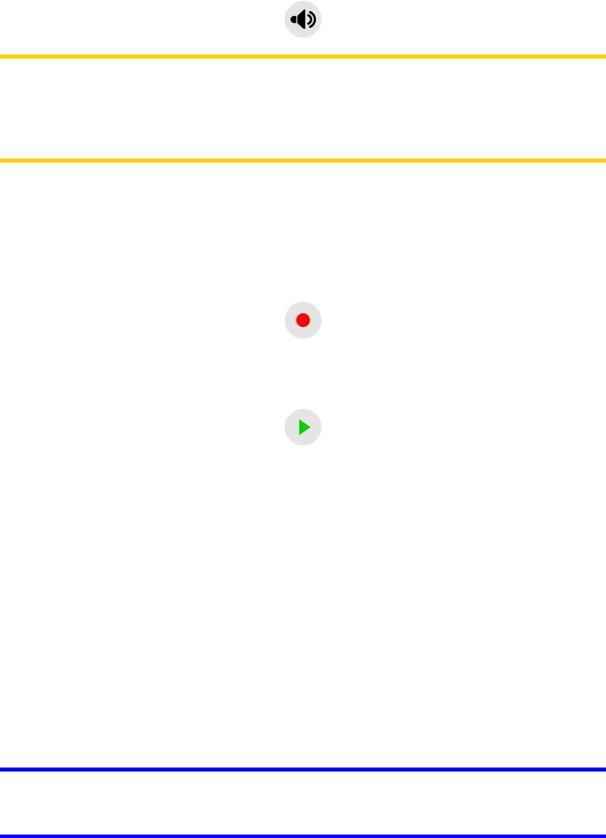
Note: Sound can be muted in Sound settings (Page 74), too. There you have a Master switch that works together with the switch described above. There is also a
Master slider on that screen. That you can use to fully turn down the volume of the device. Setting the volume low is different from muting, therefore it will not show up on the mute indicator.
4.2.12Track Log recording/playback indicator (No. 14)
When a track log is being recorded, a red icon is displayed on the map screens. This icon also functions as a button leading to the Track Log screen (Page 44) where you can stop the recording or make the track log visible on the map.
During track log playback a green icon will blink. Tapping this icon (in fact, tapping the screen anywhere) stops the simulation.
4.2.13Cursor menu (No. 15)
The Cursor is the selected point on the map (marked by a red dot and radiating red circles around it), or the current GPS position when it is available and Lock-to- Position is enabled. When you tap the screen to place the Cursor, the Cursor menu pops up automatically to give you the list of possible functions you can use the
Cursor for. At the same time Popup Info (street name, house number and the list of
POIs nearby) appears near the selected map point if Popup Info is enabled in the Quick menu (Page 40).
If you do not use the Cursor menu in a few seconds, it will automatically vanish back to the bottom of the screen, and Popup Info disappears, too. You can have them reappear by reopening the Cursor menu using the arrow in the bottom right corner. When you open the menu manually, it will stay on until you close it or switch to another screen.
Tip: If you want to see the map around the Cursor, close the Cursor menu and reopen it. When this menu is opened manually, the map is always moved to have the cursor in the center.
28
